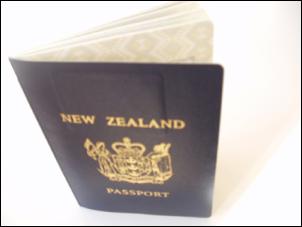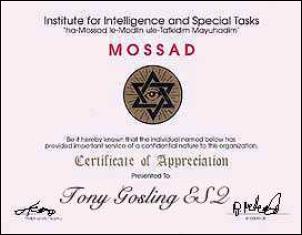Do You Believe In Spooks Downunder Inc?
Do You Believe In Spooks?
Have Israeli Spooks Materialised Downunder?
By Selwyn Manning – Scoop Co-Editor
Events over the past month have turned many toward the shadows. Names of New Zealand organisations like the SIS, EAB conjure feelings of suspicion and intrigue. Outward, beyond our borders, lurk more spooky counterparts like the USA’s CIA, Britain’s MI6, and Israel’s Mossad. Even television drama is turning New Zealanders into spook fanatics.
But has one of the world’s most notorious covert agencies, the dreaded Mossad, been active in Auckland City? Are suspicions that a group of Israeli intelligence connectives have been active attempting to obtain a New Zealand passport for a covert operation, sound? Or are events central to a Police investigation titled Operation Cloak sheer fiction of the James Bond kind?
Perhaps we will never know. What we do know is, despite this country’s geographical isolation, this sort of operation is not new to New Zealand.
In 1991, Anvar Kadyrov was deported to the Soviet Union for attempting to obtain a New Zealand passport using a copy of a birth certificate of a deceased New Zealand child, and after the then Prime Minister, Jim Bolger, said Kadyrov was a member of a Soviet intelligence agency.
More recently a Finnish national was convicted of attempting to acquire a New Zealand passport using the names of mentally disabled people.
And in March 2004, the New Zealand Police pounced on a group that they believe was operating with sinister motives, unofficially the Police and the New Zealand Government seem suspicious that the group is indeed connected, in some way, to the Mossad.
New Zealand Passports A Prized Black Market Item
 In many Asian
Capitals, New Zealand passports are keenly sought – the
price for an entry-level forgery going for $500 USD.
In many Asian
Capitals, New Zealand passports are keenly sought – the
price for an entry-level forgery going for $500 USD.
A Scoop Asia-based contact suggests the lowest level market price for a New Zealand passport is $500 USD. This buys the clandestine traveler a “basic job” that entails changing the photograph from the original owner to the buyer’s image, a change of name, date of birth. Alternatively, the original passport owner’s name would remain with a simple photo-swap satisfying assured travel through Asia, Middle East and Pacific Islands.
The next level, would buy a very skilled forgery, using a stolen new generation NZ passport. This would cost the buyer around $1500 USD. While this level of passport would likely provide security for the dodgy traveler throughout many European countries, it would not be sophisticated enough to ensure travel in and out of New Zealand or Australia, or indeed the United States.
Another contact suggests, if a buyer, crook, or sub-government operative wants assurance that a passport would pass checks within the NZ system, he or she would need the real McCoy. Obtaining this level of passport attracts significant risks.
In days past, covert operatives, both criminal and sub-government, have used the old ruse: obtain a birth certificate of a deceased person, build a documented identity, driver’s license, passport, bank accounts, if required a tax record.
Today, internal affairs departments worldwide are wise to this method. To establish a sound legend in this information-age requires a higher degree of research. But this, and again, attracts increased risk.
To obtain a new identity that’s hard for authorities to crack requires documents built around a living person – preferably one who cannot or could not travel abroad. A perfect living example would be an intellectually disabled person or quadriplegic.
Scenarios abound since reports surfaced that Zev Barkan remains wanted by New Zealand Police for allegedly attempting to illegally obtain a New Zealand passport.
 Zev William Barkan
(37), possibly a false name, also answers to the name Jay,
was staying at a flat in Sandringham, Auckland City. New
Zealand authorities believe he has left New
Zealand.
Zev William Barkan
(37), possibly a false name, also answers to the name Jay,
was staying at a flat in Sandringham, Auckland City. New
Zealand authorities believe he has left New
Zealand.
Barkan is a short, solid built, Caucasian male, has thick black hair, an American accent, said he was from Washington DC, worked for a windows and doors company, and was in New Zealand to do a sailing course. Barkan was last known to be in New Zealand March 3 to 20.
Police allege that on March 12, Barkan approached Travcour (Auckland company which specialises in obtaining visas and travel documents) to arrange a passport in the name of a New Zealand cerebral palsy sufferer. Police say Barkan opened a mailing address in the quadriplegic New Zealander’s name, a phone answering service was set up, also in the New Zealander’s name (name suppressed by Auckland District Court).
Barkan allegedly visited a Lynfield General Practitioner, Howard Way, with a “minor ailment” –the doctor was asked to witness a passport application, also in the name of the New Zealand quadriplegic’s name – the doctor signed as a witness to the document.
One Scoop source says this aspect of Operation Cloak suggests an air of sophistication. Why would a group go to such lengths to obtain a New Zealand passport? One scenario, another source says, would suggest an operation specific to the Australasian region: “That's very interesting, the person using it needing to be able to get in and out of NZ through the front door.”
But surely, an agency such as Mossad could print its own passports?
“Mossad could conceivably have a batch (of passports) printed in Israel using its Government’s printers but this poses a problem. Mossad does not employ printers full time and they would have to be seconded from the mint.”
Such a link would expose Mossad to potential scrutiny.
“My take on this case,” the Scoop contact says, “is that these guys would be trying to develop a strong legend for the NZ passport user.”
Enter The Mossad?

Mossad insiders, now on the outside, say the Mossad has just 30 to 37 case officers called katsas operating at any one time. The Mossad is able to function on a low number of core katsas due to a loyal Jewish community outside Israel. The loyalists are networked via a system of sayanim, or volunteer Jewish helpers.
Sayanim loyalists are usually Jewish, live outside of Israel, and are often recruited via Israeli relatives.
There are reportedly thousands of sayanim around the world. Their role will be specific to their professions: A loyalist in the travel industry could help Mossad obtain documents.
Sayanim offer practical support, are never put at risk, and are certainly not privy to classified information. A sayan in the tenancy business would find accommodation, financiers, doctors, civil servants, care-givers employed caring for the severely disabled… all have a part to play without knowing the complete or bigger picture, and will remain silent due to loyalty to the cause.
Katsas in charge of active sayanim will visit once every three months involving both face-to-face meetings and numerous telephone conversations.
“The system allows the Mossad to work with a skeleton staff. That's why, for example, a KGB station would employ about 100 people, while a comparable Mossad station would need only six or seven.”
Many covert activities - mainly in New York and Washington belong to a special division of the Mossad called simply Al, Hebrew for "above" or "on top."
More Questions Than Answers
Were the men arrested in Auckland Sayanim? Was Mossad hovering in a centralised position, keeping itself at arm’s length, operating like a cell to procure the passport? If Cara and Kelman were Sayanim, would they know what the whole picture was? Has a Mossad katsas co-ordinated a semi-underworld group to acquire a clean passport for an operative whose current identities have been ‘dirtied’? This is all supposition. If considered, would it explain the 'cannot be Mossad because of the pick-up bungle' argument?
Examining the alleged operation, it appears the sophisticated part, and arguably most significant, is that the group allegedly researched and targeted a quadriplegic to steal his true identity to provide a secure ‘legend’ for Zev William Barkan. The New Zealander, who almost had his identity stolen from him, is a severely disabled man who would have little chance of ever travelling abroad. Considering the alleged operation, the choice of true identity, as opposed to the picking a dead birth-certificate, would suggest significantly more research, and attract significant risk. Why was this so necessary, so important? Sources suggest this aspect of Operation Cloak is the most disturbing.
Was Barkan the important figure that a legend was being developed for? If so, why was assured travel throughout Australasia essential to the operation? Sources suggest too, a motivation would be more to ensure assured travel into New Zealand as opposed to other nations.
Was the fourth person (believed to still be in New Zealand) a worker in a residential care home, a civil servant, or do they have some other way of obtaining information about people who are severely disabled and likely never to travel overseas?
Here’s a scenario – again it is mere supposition: Were Cara and Kelman simply document procurers whose job was to source and find identities? This considered, they work in with an informant (the fourth person). Then when someone needs a new identity for a mission (for example Barkan) Cara and Kelman set it up so the operative can fly into the country, lodge the application and leave the country soon afterward. Once the passport is issued, Cara and Kelman pick up the passport for the operative and forward it on.
Barkan, or the operative who needs the new identity, has it in his/her hot hands without being exposed too much. If things go wrong, they are nowhere to be found.
Watch this space…
For
more on this issue, see…
Backgrounders…


 Eugene Doyle: Before It’s Too Late - Reimagine New Zealand’s Military Future
Eugene Doyle: Before It’s Too Late - Reimagine New Zealand’s Military Future  Binoy Kampmark: Gender Stunts In Space - Blue Origin’s Female Celebrity Envoys
Binoy Kampmark: Gender Stunts In Space - Blue Origin’s Female Celebrity Envoys Richard S. Ehrlich: A Deadly Earthquake & Chinese Construction
Richard S. Ehrlich: A Deadly Earthquake & Chinese Construction Ian Powell: It Does Matter To Patients Whether They Are Operated In A Public Or Private Hospital
Ian Powell: It Does Matter To Patients Whether They Are Operated In A Public Or Private Hospital Gordon Campbell: On Marketing The Military Threat Posed By China
Gordon Campbell: On Marketing The Military Threat Posed By China Binoy Kampmark: Olfactive Implications - Perfume, Power And Emmanuel Macron
Binoy Kampmark: Olfactive Implications - Perfume, Power And Emmanuel Macron